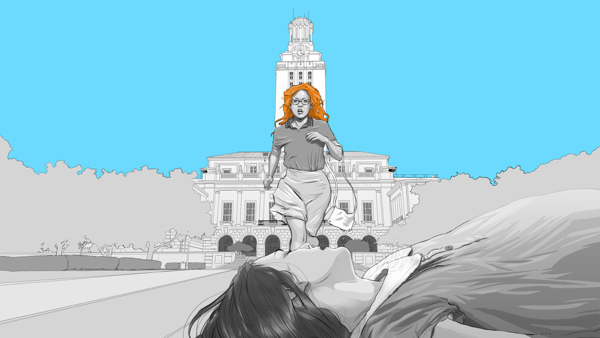Movie review by Greg Carlson
Now on Netflix instant watch and not to be missed is director Keith Maitland’s “Tower,” one of the most memorable and gripping films of 2016. Carefully, even meticulously, constructing a moment-by-moment chronological account of the 1966 University of Texas at Austin murders committed by Charles Whitman from the observation deck of the Main Building, Maitland’s film relies on the use of interpretive performance and rotoscope animation — two fairly unorthodox stylistic choices in nonfiction. The approach, however, is a spellbinding display of fully human reactions to what was at the time a virtually unthinkable, unfathomable action.
Maitland focuses on those directly involved in Whitman’s crime, developing for the viewer a sense of deep identification with lawmen, casualties, and first responders. The director also deliberately avoids any psychological profiling of Whitman as deranged and monstrous antagonist, positioning the sniper behind the distant reports from his rifle that registered to witnesses as puffs of smoke along the tower’s ledge. That decision both honors the innocent people caught in the assassin’s crosshairs and heightens the sense of urgency and immediacy of the date by sharing with the audience a sense of the confusion, panic, and uncertainty that gripped the campus.
Although she was not Whitman’s initial victim, 18-year-old Claire Wilson was the first person shot from the tower. Wilson, who lost both her unborn son and her boyfriend Thomas Eckman to the killer’s bullets, could not move from the hot sidewalk where she fell, and Maitland uses her story as a key to understanding the astonishingly selfless displays of courage shown by strangers during the terrifying ordeal. Rita Starpattern, who happened upon the scene and stayed on the ground next to Wilson, held her hand and shared encouragement until John “Artly” Fox and James Love put themselves in harm’s way to move Wilson to safety.
Maitland eventually reveals, in direct, close-up portraits, the subjects previously portrayed by actors in the animated reconstructions. These moments — effectively withheld for maximum impact — are startlingly concrete. Bridging past and present, the revelations and reunions cathartically pulsate as we watch the older versions of the fated cohort traverse time itself. Wilson and Fox, Aleck Hernandez Jr., officers Ramiro “Ray” Martinez and Houston McCoy, along with several others, are given the opportunity to share with us, and in some cases, each other, thoughts that might otherwise have gone unexpressed.
“Tower” is based partly on executive producer Pamela Colloff’s 2006 “Texas Monthly” oral history “96 Minutes,” and if there is anything missing from the film experience, it is the necessary omission of comprehensive coverage of all the day’s details (more than a dozen were killed and more than 30 were injured). But Maitland, like Ari Folman in “Waltz with Bashir” and others, has explored the ways in which we might arrive at truth. “Tower” expands the vocabulary we can use when thinking about the presentation of fact-based content in the movies.
In a valuable essay, Nea Ehrlich wrote about animation and the nonfiction film, saying of “Waltz with Bashir,” “Despite its stylized imagery, the film clearly signifies recognizable references that could not be documented otherwise. By referring to personal views of reality and memories, the non-mimetic imagery does not diminish the truth value of the film’s documentation because it refers to aspects of reality that cannot be directly indexed as they do not physically exist.” Ehrlich could just as easily have been writing about “Tower.”
